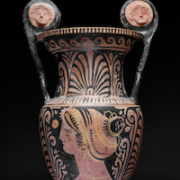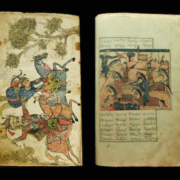Mughal Empire artisans raised arts of Asia to new heights

A Mughal Empire gold pendant inlaid with kundan-set green glass, white topaz and rubies sold for $2,500 plus the buyer’s premium in December 2021. Image courtesy of Artemis Gallery and LiveAuctioneers
NEW YORK – In 1526, the Mughals, descendants of the Mongol leaders Tamerlane and Genghis Khan, created an empire stretching from the Indus Valley and northern Afghanistan to sub-continental India. The empire endured until the 19th century, and flourishing trade sparked Mughal artisans to innovate within a wide range of arts and crafts, from textiles to painting to jewelry to beautifully decorated weapons.
Palatial Mughal rugs commissioned by the Imperial court initially featured classic sinuous or arabesque designs borrowed from neighboring Persia. Later designs, produced in Agra and in other royal sub-continental Indian workshops, merged highly detailed, densely knotted Persian and Chinese designs with vibrantly colored local elements. Many feature stylized animals or lush plant and flower motifs in bold shades of green, deep red and yellow. Others depict expansive panoramas, court scenes or royal hunting parties.

This antique Agra rug, made in India, earned $1,700 plus the buyer’s premium in February 2020. Image courtesy of Material Culture and LiveAuctioneers
Today, “Agra” is a generic term for 18th- and 19th-century Mughal rugs, many inspired by extensive exposure to Renaissance European tapestries and paintings. The sumptuous, warm-hued antique Agra rug that Material Culture auctioned for $1,700 plus the buyer’s premium in February 2020 evokes the wealth and splendor of the Mughal royal court.
Mughal ornamental calligraphy, one of the main elements of Islamic art, also emerged from the Persian tradition. Indeed, P.I.S. Mustafizur Rahman wrote in Mughal Calligraphy (an article printed in a 1987 issue of Islamic Studies) that “by means of its abstract elements, such as the verticals, horizontals, angles, ovals, circles, curves, loops, twists, and turns, commends itself to quench the thirst emanating for the search for God.” In other words, artful calligraphy was an act of piety.

This ovoid-shape agate pendant graced with a textured central panel and reserved calligraphic text amid bands of calligraphic text sold for £360 (about $428) plus the buyer’s premium in September 2018. Image courtesy of TimeLine Auctions Ltd. and LiveAuctioneers
Because Mughals regarded calligraphy as spiritually powerful, they often incised inscriptions into amulet-plaques or pendants fashioned from semi-precious stones such as banded agate, carnelian or nephrite jade. Pieces of jewelry that were believed to cure an array of maladies were graced with Koranic verses. A charming crimson agate pendant TimeLine Auctions sold for $428 plus the buyer’s premium in September 2018 bore central calligraphy designs banded by more detailed texts that might reflect the sayings of the prophets.
Mughal miniatures also emerged from the Persian tradition. Large, luxurious leather-bound volumes of the petite paintings depicted significant events as well as the grandeur of the royal court. One-off images featuring Mughal mythology, legends, portraits and noted battles were produced as well. Many of these meticulously detailed images, though fanciful, reveal intriguing aspects of daily court life. A radiant watercolor miniature that earned $16,000 plus the buyer’s premium for Neue Auctions in February 2021, for example, shows a haloed, extravagantly dressed emperor seated upon a jeweled throne and brandishing a scimitar.

A Mughal opaque watercolor and gold on paper miniature depicting an emperor seated upon a jeweled throne chair brought $16,000 plus the buyer’s premium in February 2021. Image courtesy of Neue Auctions and LiveAuctioneers
The Mughal Empire, seized by the sword, defended its conquests with cannons, muskets, maces, spears, battle axes and blunderbusses. Yet decorative arms, such as the gold and enamel horsehead-adorned dagger that Hindman auctioned in June 2022 for $10,000 plus the buyer’s premium, were most desirable of all.

A Mughal gold and enameled horsehead dagger from the 17th or 18th century realized $10,000 plus the buyer’s premium in June 2022. Image courtesy of Hindman and LiveAuctioneers
Mughal cavalry, famed for its fierce horsemanship, favored lightweight bows and arrows. Unlike Central Asian versions, Mughal cavalry weapons were painted and lacquered to withstand sub-continental Indian heat and humidity. A handsome, curved 17th- to 18th-century bow-and-arrow set featuring running foliage designs earned £1,100 (about $1,308) plus the buyer’s premium at TimeLine Auctions in May 2014.

Four Mughal arrows and a painted, lacquered recurved wooden bow featuring running foliage designs attained £1,100 (about $1,308) plus the buyer’s premium in May 2014. Images courtesy of TimeLine Auctions Ltd. and LiveAuctioneers
The Mughal infantry, on the other hand, prized long, massive forged blades. Auctions Imperial Inc. sold a striking early 18th-century tulwar sword, its hilt inlaid with elegant gold and silver vine work, an Arabic inscription and marks indicating possession by the Mughal emperor, for $121,000 plus the buyer’s premium in November 2021.
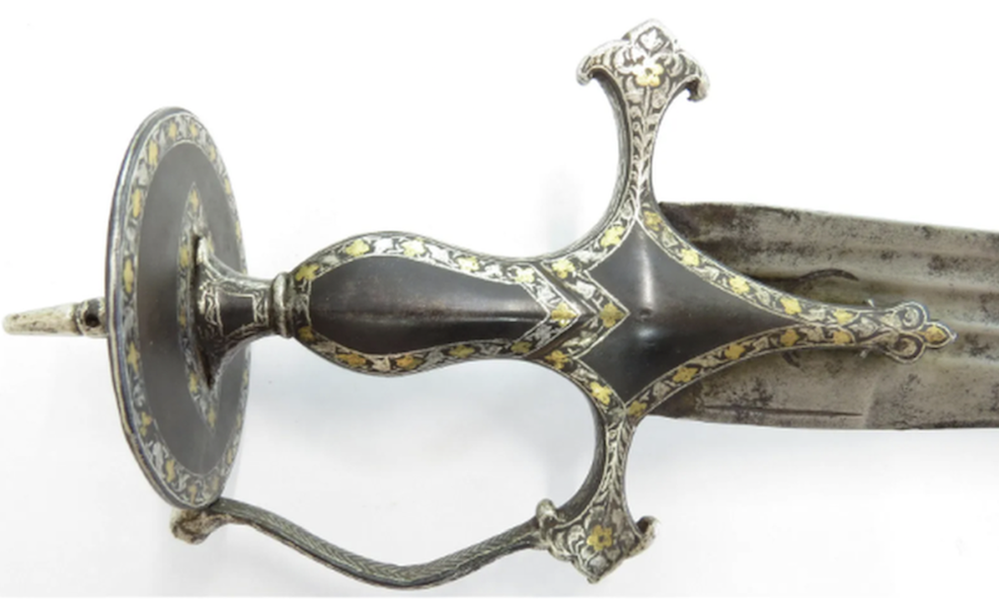
This Imperial tulwar sword, featuring intricate inlaid gold and silver vine work and inlaid marks indicating possession by the Mughal Emperor, achieved $121,000 plus the buyer’s premium in November 2021. Image courtesy of Auctions Imperial Inc. and LiveAuctioneers
The Mughal court adored opulent gemstone jewelry for its protective powers, the high social status it represented and the power it radiated. To maintain its exclusivity and value, royals limited the production of the jewelry, controlled its circulation and restricted its ownership to the upper classes.
Mughal earrings, turban adornments, necklaces and pendants typically featured valuable stones outlined with pure shimmering gold known as “kundan” gold. Artemis Gallery offered a splendid crescent-shaped kundan pendant inlaid with green glass, white topaz and rubies in December 2021 that realized $2,500 plus the buyer’s premium. Kundan jewels also ornamented everyday items such as perfume bottles, mirrors, bowls, spoons, hookah bases and paan (betel leaf) boxes.
To some, Kundan designs evoke cloisonne, ancient decorative enamels that also feature partition work. Indeed, some suggest that cloisonne reached China from Islamic lands when it was part of the Mongolian Empire. Centuries later Mughal jewelers, perhaps inspired by India’s exquisite goldwork and abundance of fine jewels, adapted those Islamic-based techniques to create their luminous works.
Mughal craftsmen produced some of the most spectacular creations ever known by deftly merging Chinese, Islamic, Mongolian, Persian and Indian artistic traditions. Their masterpieces are still cherished centuries later, and will be for centuries to come.


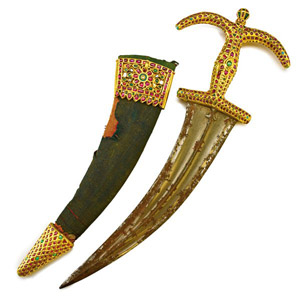
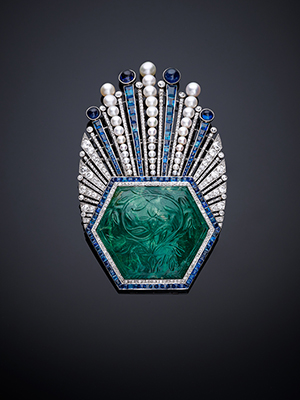
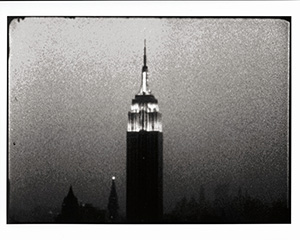
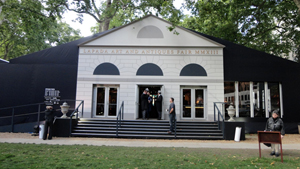

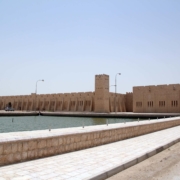
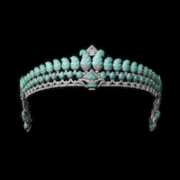
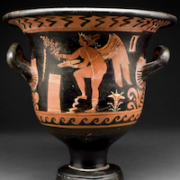 Apollo Art Auctions, London
Apollo Art Auctions, London